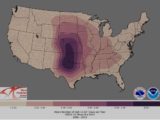For anyone who lives in Texas, the occasional hailstorm is something we just get to live through from time to time. There’s no way to predict when and where they will happen until just a few moments before the icy stones start to drop from the sky, but we do know without doubt they will happen.
Texas is far from the only state where the occasional hailstorm hits. As the map here–prepared by the Storm Prediction Center in Norman, Okla., using data from National Weather Service and NOAA shows–the nation’s entire breadbasket lies in the fairway for frequent hail activity.

Most people in these areas understand the risks and know they might have to replace a roof or two in their lifetimes following a particularly severe event. My wife and I lost the use of our car for several weeks in 2022 after it was hit by a severe hailstorm with golf-ball size stones while we were in a theater in downtown Fort Worth. The car sat in the shop for weeks because that storm damaged thousands of other cars in the area. This stuff happens – we know it, and just have to be prepared to deal with the carnage when it comes.
Anyone with common sense would think that developers of the rapidly multiplying number of big solar industrial sites all over Texas and the Midwest would understand the risks at play here as well. But if they do think about it, it’s not really evident to the public.
The Dallas-Fort Worth Metroplex sits in one of the most active hail regions on Earth, yet solar sites are popping up all across the six-county area nonetheless. It’s only a matter of time until any or all these facilities are hit by a hailstorm, yet these sites do not seem to have any real defense mechanisms in place, other than to change the tilt angle of the panel arrays in the hopes of deflecting the stones with minimal damage.
Last week, a major solar array occupying more than 3,000 acres of arable lands south of Houston was struck by a storm carrying golf-ball-size hail. Such stones are not especially large – several Fort Worth citizens were killed in 1995 when a storm carrying softball-size stones hit an annual outdoor festival called Mayfest – and happen frequently. Yet, this array outside Damon, Texas, had no defense mechanism in place, and was devastated as a result.
One X user who posted a video of the carnage posed a really good question: Who will now pay for the mess? One would assume the solar developer has some sort of insurance policy in place, so the initial repairs would be borne by those two parties.
But in the longer run, it is fair to project that those costs will inevitably be passed onto utility customers in Texas in the form of inflated electricity bills. Federal taxpayers will also wind up footing a portion of the bill for devasted solar sites in the form of even higher subsidies that will inevitably be sought to keep the developers and their industrial installations in business.
Another cost that boosters of so-called “clean” energy like solar prefer to avoid talking about is the cost involved in disposing of these thousands of damaged panels and properly handling and recycling their toxic content. While the boosters love to wax eloquent about how easy it is to recycle these things, the truth is that few recycling facilities currently exist and most of these things will likely just be hauled off to local dump sites. Unfortunately, neither Texas nor apparently any other state in the US has sophisticated regulations governing any of this.
This is just a small snapshot of the national mess America and other western countries are in the process of creating in their mad rush to a nebulous, ill-defined “net-zero” by 2050. We are only beginning to experience the consequences to come.
David Blackmon is an energy writer and consultant based in Texas. He spent 40 years in the oil and gas business, where he specialized in public policy and communications.
The views and opinions expressed in this commentary are those of the author and do not reflect the official position of the Daily Caller News Foundation.
All content created by the Daily Caller News Foundation, an independent and nonpartisan newswire service, is available without charge to any legitimate news publisher that can provide a large audience. All republished articles must include our logo, our reporter’s byline and their DCNF affiliation. For any questions about our guidelines or partnering with us, please contact licensing@dailycallernewsfoundation.org.


